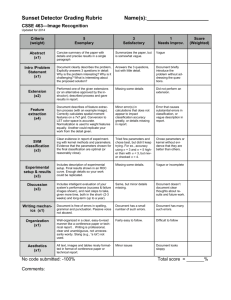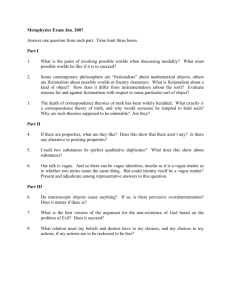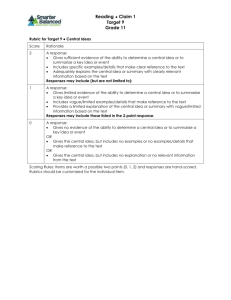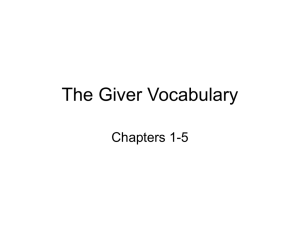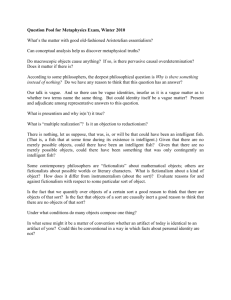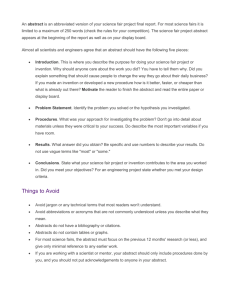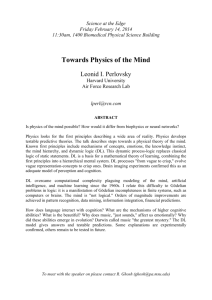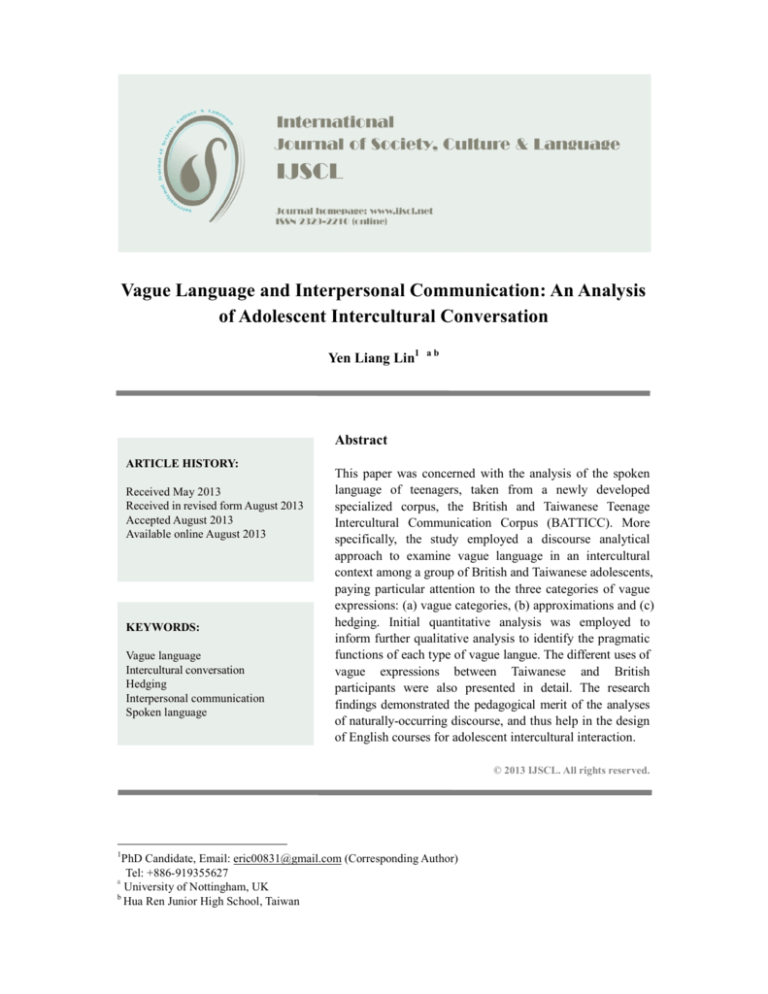
Vague Language and Interpersonal Communication: An Analysis
of Adolescent Intercultural Conversation
Yen Liang Lin1
ab
Abstract
ARTICLE HISTORY:
Received May 2013
Received in revised form August 2013
Accepted August 2013
Available online August 2013
KEYWORDS:
Vague language
Intercultural conversation
Hedging
Interpersonal communication
Spoken language
This paper was concerned with the analysis of the spoken
language of teenagers, taken from a newly developed
specialized corpus, the British and Taiwanese Teenage
Intercultural Communication Corpus (BATTICC). More
specifically, the study employed a discourse analytical
approach to examine vague language in an intercultural
context among a group of British and Taiwanese adolescents,
paying particular attention to the three categories of vague
expressions: (a) vague categories, (b) approximations and (c)
hedging. Initial quantitative analysis was employed to
inform further qualitative analysis to identify the pragmatic
functions of each type of vague langue. The different uses of
vague expressions between Taiwanese and British
participants were also presented in detail. The research
findings demonstrated the pedagogical merit of the analyses
of naturally-occurring discourse, and thus help in the design
of English courses for adolescent intercultural interaction.
© 2013 IJSCL. All rights reserved.
1
PhD Candidate, Email: eric00831@gmail.com (Corresponding Author)
Tel: +886-919355627
a
University of Nottingham, UK
b
Hua Ren Junior High School, Taiwan
70
Vague Language and Interpersonal Communication: An Analysis of Adolescent Intercultural Conversation
1. Introduction
I
t is accepted that maintaining good relations
between the speaker and hearer is important
in casual face-to-face conversation,
particularly in intercultural communication.
O’Keeffe, McCarthy, and Carter (2007) propose
the term “relational language” to refer to
language that serves to “create and maintain a
good relationship between the speaker and
hearer” (p. 159). One such device is vague
language, which is found to be particularly
common in daily conversation as speakers are
often cautious not to sound over definite, which
might be perceived as threatening or
over-educated (Carter & McCarthy, 2006;
Cheng & Warren, 2003; O’Keeffe et al., 2007).
Vague language, therefore can have an informal,
“socially cohesive function” (Cutting, 2007, p.
3). O’Keeffe et al. (2007) also note that one
central function of vague language is to hedge
assertions or to make them fuzzy by allowing
speakers to downtone what they say. In this
regard, vague language softens expressions, so
the speakers “do not appear too direct or unduly
authoritative and assertive”; the use of vague
expressions is therefore a conscious choice by
speakers and is not a product of careless
thinking or sloppy expression (Carter &
McCarthy, 2006, p. 202).
There has been a burgeoning field of research
looking at vague language in different social
contexts, identifying different kinds of vague
expressions and describing how they are
employed in a particular setting. Koester (2007),
for example, investigated conversations across a
variety of office environments and shows that
vague language occurs regularly in work-related
interactions. Adolphs, Atkins, and Harvey (2007)
examined the Nottingham Health Communication
Corpus (NHCC) and showed that vagueness is
extremely common in health communication
contexts and plays an important part in the
negotiation of advice and thus in affirming
patient choice. Moreover, Parvaresh and Dabghi
(2013) looked at vagueness across languages.
Their comparative studies reported on the extent
to which transfer takes place from Persian into
English as a Foreign Language (EFL) discourse.
Lin (2012) compared and contrasted vague
expressions used in EFL textbook conversation
and authentic discourse. A significant gap
between the two datasets was identified, which
shows that vague language, which is pervasive
in authentic discourse, is rarely presented in the
EFL learning materials he examined. As such, it
is suggested that including the use of vagueness
would not only enrich the description of target
language use but also increase novices’
awareness of the patterns of use in an authentic
communication context.
2. Theoretical Framework
Vague language has been included in major
English grammar books as an important
grammatical and interpersonal feature of spoken
discourse, such as the Longman Grammar of
Spoken and Written English (Biber, Johansson,
Leech, Conrad, & Finegan, 1999) and the
Cambridge Grammar of English (Carter &
McCarthy, 2006). Biber et al. (1999) explain
that vague language conveys imprecision that
hedges and that in generic reference the noun
“refers to a whole class rather than to an
individual person or thing” (p. 265). Carter and
McCarthy (2006, p. 928) also described vague
expressions as words or phrases “which
deliberately refer to people and things in a
non-specific, imprecise way”, such as stuff, like,
or anything, or whatever, sort of and
approximations, as in “around six”. Channell
(1994) defines vague language as a language
which “can be contrasted with another word or
expression which appears to render the same
proposition” and which is “purposely and
unabashedly vague” (p. 20). Her analysis of
vague expressions shows that “their meanings
are themselves vague”, and that “speakers share
knowledge of how to understand them” (p. 196).
This also accords with O’Keeffe et al.’s (2007)
definition, vague language indicates “assumed
or shared knowledge and mark in-group
membership” (p. 177). In other words, it is “a
marker of intersubjectivity” (Overstreet & Yule,
2002, p. 787). The interlocutors, in this case, do
not need to convey precise and concrete
information simply because they are accustomed
to relying on a common ground of knowledge
Y. L. Lin/ International Journal of Society, Culture & Language, 1(2), 2013
and belief shared with others. As Channell
(1994) notes, “any social group sharing interests
and knowledge employs non-specificity in
talking about their shared interest” (p. 193).
Although discourse communities use vague
language to assert in-group membership and
show solidarity, critical discourse analysis takes
a different point of view, considering vagueness
as a social divider. Wodak (1996) explains that
confusion can result when there are “gaps
between distinct and insufficiently coincident
cognitive worlds”, since these can separate
“insiders from outsiders, members of institutions
from clients of those institutions, and elites from
the normal citizen uninitiated in the arcana of
bureaucratic language and life” (p. 2). This
notwithstanding, vague language is pervasive in
everyday talk, serving interpersonal and
pragmatic functions in discourse. Carter (1998)
sees it as a social leveller: it “puts the speakers
on an immediately casual and equal footing with
their interlocutors” (p. 45). Several studies have
also reported that vague language is typical of
adolescent speech (Cheshire, 2007; Martínez,
2011; Stenström, Anderson, & Hasund, 2002;
Tagliamonte & Denis, 2010; Winter & Norrby,
2000). Stenström et al. (2002), for example,
analyzed the Bergen Corpus of London Teenage
Language (COLT) and noted that “in the
teenage world it is cool to be vague, and it is
cool to demonstrate that one cannot be bothered
to be precise” (p. 88). Nevertheless, some
researchers report that adults actually use more
vague language overall than teenagers, though a
wider range of different forms of vague
expressions is found in the teenage data (e.g.,
Martínez, 2011). While different variations
regarding the frequency of vague language use
can be found in the comparison of adult and
teenage data, vague expressions usually have
“the purpose of expressing solidarity,
self-connection and assumption of shared
experience” (Martínez, 2011, p. 2468). Vagueness
is therefore motivated and purposeful and it is
often a mark of sensitivity and the skill of a
speaker. Although vague language used in
various contexts has been extensively studied,
little is known about their use in adolescent
ISSN 2329-2210
learners of English who take part in intercultural
exchanges. This paper employs a discourse
analytical approach to examine vague language
used in an intercultural setting among a group of
Taiwanese and British adolescents, paying
specific attention to the three categories of
vague expressions: (a) vague categories, (b)
approximations and (c) hedging. Initial
quantitative analysis is employed to inform
further qualitative analysis to identify the
pragmatic functions of each type of vague
langue. The different use of vague expressions
between Taiwanese and British participants will
also be presented in detail.
3. Methodology
3. 1. Participants
This study is based on a global partnership
program “British Council Connecting Classrooms
Project” that aims to create global partnerships
between clusters of schools in the UK and
others around the world, and thus offer language
learners an opportunity to communicate and
work directly with their international peers
(British Council, n.d.). The participants
recruited for the study were 35 Taiwanese
learners from Hualien and 35 English secondary
school students from Cumbria, between 13 and
14 years of age, all participating in the
Connecting Classrooms Project. Most of the
Taiwanese participants are English learners at a
low-intermediate level, having learned English
for averagely five to six years, and nearly all
(97.5%) have never had the experience of
interacting with students with a different
linguistic background, and particularly from
English-speaking countries. Similarly, few of
the English participants have a friend or an
online pen pal from an Asian country.
3. 2. Corpus
Since this study aims to examine the particular
linguistic features of spoken communication, an
analysis based on naturally occurring samples of
language data is necessary. British and
Taiwanese Teenage Intercultural Communication
Corpus (BATTICC), a specialized corpus,
71
72
Vague Language and Interpersonal Communication: An Analysis of Adolescent Intercultural Conversation
therefore can be of value as it represents the
language use of specific people in specific
contexts. The data that forms the basis of
BATTICC was collected from casual face-to-face
conversation in an intercultural exchange project,
involving British and Taiwanese teenage
participants between 13 and 14 years of age.
This spoken data collection resulted in
approximately 4 hours of recorded chats,
amounting to a total of approximately 34,089
words, transcribed in accordance with standard
orthographic practices in order to facilitate
analysis by currently available corpus analytical
tools.
With regard to the construction of a corpus,
representativeness and sampling are two
essential criteria. McEnery, Xiao, and Tono
(2006) note that these are the features typically
used to distinguish a corpus from an archive.
That is, an archive is simply a random collection
of texts whereas a corpus is designed to provide
insight into a particular genre. In this study,
BATTICC was constructed to present the
informal nature of intercultural communication
by adolescent learners in a face-to-face setting.
As such, all the samples collected represent that
genre. Biber (1995) defines representativeness
as the extent to which a sample includes the full
range of variability in a population. This
suggests that one should strive to collect
samples from all the possible situations within a
certain genre to completely present the language
being studied. However, for collecting spoken
discourse, it does not seem to be possible to
record all of the spoken interactions in the
participants’ daily lives. Koester (2010)
suggests that what is important is to ensure that
the samples are collected from a range of fairly
typical situations. In this regard, as the aims of
the intercultural exchange project were to build
relationships between participants in casual
settings, spoken data for BATTICC were
collected from a range of informal chats
between Taiwanese and British participants
during the intercultural exchange program, in a
wide variety of locations such as schools, homes,
restaurants, tourist spots, public parks, and
social gatherings, wherever possible consisting
of the entire speech event. Nevertheless, it needs
to be noted that this paper has attempted to
demonstrate the particular linguistic patterns
(i.e., vague expressions) via a case study of
adolescent intercultural exchange project, and
consequently the sample might not lead to any
generalizable observations for intercultural
interaction in general.
3. 3. Procedure
The analytical framework adopted in the current
study for describing and analyzing vague
language was drawn from the work done by
Channell (1994), since her work provides a
systematic and rigorous description of vague
language used in real and varied contexts of
communication. The framework has also been
applied effectively to a variety of contexts of
interaction (e.g., Adolphs, Atkins, & Harvey,
2007; Drave, 2000; Koester, 2007; Lin, 2012;
Stenström et al., 2002). In this study, three
categories of vague language are examined: (a)
vague categories, (b) hedging and (c)
approximations. Vague categories involve the
use of words and phrases such as kind of thing,
and stuff, and so on and things like that, which
deliberately refer to sets or categories of items
in an imprecise way. The speakers in this case
do not necessarily convey precise and concrete
information, and the hearers in most cases know
what their vague expressions refer to (Carter &
McCarthy, 2006; O’Keeffe et al., 2007;
Overstreet, 2011). This use of vague language is
sometimes given different labels, such as
“general extenders” (Overstreet & Yule, 2002;
Parvaresh & Dabghi, 2013), “extension
particles” (Dubois, 1992), “vagueness tags” (De
Cock, 2004), “set marking tags” (Winter &
Norrby, 2000), “vague category identifier”
(Channell, 1994) and “vague category markers”
(Evison, McCarthy, & O’Keeffe, 2007;
O’Keeffe et al., 2007).
The second major category of vague language
includes the expressions which serve to hedge
the commitment of the speaker to what he or she
asserts in my data so that utterances are softened
in some way and they are slightly more indirect
and less assertive. I particularly focus on
Y. L. Lin/ International Journal of Society, Culture & Language, 1(2), 2013
adverbial hedges, such as “a bit confusing”,
“sort of tricky”. Approximations, which are
often described as vague language used with
numbers and quantities, are included in another
type of vagueness in the current study, as in
“around six”, “a couple of days ago”. They are
also described as “vague additives” (Channell,
1994) or “vague approximators” (Koester, 2007).
They are commonplace in the domain of
measurements and quantitative data, which have
the effect of blurring category boundaries or
otherwise precise measures (Adolphs et al.,
2007). The corpus analytical tool WordSmith 5.0
was used to determine the frequency of the
vague items in BATTICC, and these were
73
ISSN 2329-2210
examined in their discourse contexts to find the
functions they performed.
4. Results
The use of vague language falls into three
aspects: vague categories, hedging, and
approximations. Table 1 presents the total
number of instances for each type of vague
expressions, which will be discussed in the
following three subsections. The table also
shows statistically significant differences in the
amount of use between the two groups of
participants revealed by using log-likelihood
ratios (Rayson, 2008) to compare the cumulative
frequencies of each item.
Table 1
"umber of Different Vague Expressions
Vague expressions
Taiwanese
British
Sig.
Number per 1000 words
(LL)
Number
per 1000
(and) stuff (like that)
2
0.36
15
1.33
p<.05
(that/this) sort of (thing/like)
0
0.00
12
1.06
p<.01
(or) anything (like that)
2
0.36
10
0.89
(or/and) something (like that)
7
1.24
12
1.06
(that/this) kind of (thing)
3
0.53
3
0.27
(and) everything
3
0.53
7
0.62
(and/but) thing(s) (like that)
5
0.71
24
2.13
Total
21
3.91
83
7.36
p<.01
sort of
0
0.00
17
1.51
p<.001
a bit / a little bit
2
0.36
14
1.24
Total
2
0.36
31
2.75
about / around
6
1.07
6
0.53
lots of / a lot
10
1.78
34
3.02
loads of
0
0.00
8
0.71
a couple of
0
0.00
4
0.35
Total
16
2.84
52
4.61
Vague categories
Hedges
p<.001
Approximation
p<.01
74
Vague Language and Interpersonal Communication: An Analysis of Adolescent Intercultural Conversation
4. 1. Vague Categories
Vague categories refer to vague use of
categories of items. In BATTICC 104 instances
of expressions indicating vague categories were
found. As can be seen in Table 1 they typically
include words and phrases such as thing, stuff,
like, or something, or anything, kind of, and sort
of, which are found in 21 and 83 instances in the
Taiwanese and British datasets respectively.
Tests of log-likelihood revealed a significant
difference in the use of (and) stuff (like that),
(that/this) sort of (thing/like), and the
cumulative frequencies of vague categories
between the two sets of data.
Sort of is one of the most commonly used vague
expressions in the British data, while no
instances were found in Taiwanese learners’
discourse. The following extract presents how it
is used in context. In (1) BT13 and BT14 are
talking about gift ideas for their fathers. BT14
used the vague expression that sort of thing
twice, and BT13 may well know what he/she
means although no explicit reference is given.
(1) <BT14>: Right, because all of them .. all
the presents I’ve made .. you know what I
mean, like I made all the key rings they’re
more for Mum then you know ... my Dad
doesn’t like that sort of thing.
<BT13>: Yeah, I bought a load of rope
bracelets for my Dad.
<BT14>: My Dad’s not into that sort of
thing. I was going to get him like a model
or something … If I do, I’ll get him some
alcohol from duty free ...
The first use of that sort of thing may well refer
to the presents that the speakers have made
during the cultural exchange program, and this
reference appears to be a marker of shared
knowledge and experience that they can draw on.
The second use of that sort of thing refers to the
gift that BT13 bought for his/her father so the
speaker BT14 does not necessarily need to
repeat the noun phrase a load of rope bracelets,
and this in turn further asks the hearer to
construct the relevant ideas of buying a gift.
Moreover, the use of or something basically
indicates an alternative category of gifts, and
such usage simply “keeps options open” (Carter
& McCarthy, 2006, p. 202). Such use of vague
language describing categories of items is
sometimes referred to as a “vague category
identifier” (Channell, 1994), which is made up
of an exemplar (i.e., a model) plus a vague tag
(i.e., or something), where the exemplar directs
listeners to identify the category referred to.
Some more instances of vague expressions
retrieved from the BATTICC are presented in
the following excerpts:
(2) <BT07>: I know that they’re a lot more
like ... the girls have to have their hair out
of their faces and they can’t wear
make-up and stuff and ...
(3) <BT07>: But then we might not have
chance to come again because of like
money and stuff.
(4) <BT23>: So .. er ... what sort of different
things have you been noticing in our
culture and traditions and stuff?
(5) <BT18>: Yeah, so it’s like a lot fresher and
generally .... do you find that we have
fresher ... erm ... fresh vegetables or
anything like that?
(6) <BT17>: …but things like you know,
your hair or your shoes or anything –
they’re not really bothered about it.
(7) <BT08>: Erm .. .. it wasn’t like amazing
or anything. I’m just like weird anyway
so people laugh at it.
The and stuff shown in (2) may be inferred to
mean the kinds of girls’ make-up, dress and
accessories; the use of the same phrase in (3)
was used for stating the reasons that might
discourage BT07 from having another chance to
visit Taiwan, which might include funding,
school rules and other complicated restrictions
that are not easy to explain in detail. Such use of
vague expressions serves both set-marking and
interpersonal functions in conversation and is
Y. L. Lin/ International Journal of Society, Culture & Language, 1(2), 2013
probably preferred by interlocutors as it may
have distanced the speakers from the
interlocutors if they had used more formal terms,
such as cosmetics for (2) or economic hardship
for (3). Vague category identifiers sometimes
occur with an interrogative manner, i.e., being
used as a tag question, as in (4) and (5), which
likely leave room for the interlocutors to add
their own description of the situation (Adolphs
et al., 2007). In these cases, BT23 and BT18
seem to not only ask the interlocutors to
describe the differences between British and
Taiwanese cultures or the different fruits or
vegetables they have found, but also direct them
to consider an entire category of cultural
differences to share with the speakers. In
addition, it can be seen that vague category
identifiers can basically be divided into
adjunctive and disjunctive one. The former
usually begins with adjunctive coordinator and,
implying that more detailed information could
be given without actually saying so, as in (2)-(4).
The latter, on the other hand, typically begins
with or and basically indicates the existence of
alternatives (Fernandez & Yuldashev, 2011;
Parvaresh & Dabghi, 2013), such as or anything
in (5)-(7).
In some cases vague categories can be used to
exemplify the explanations (Koester, 2007), as
in (2) and (6). For example, the use of your hair
or your shoes or anything in (6) refers to the
things in the utterance, where the speaker BT17
explains the different items related to school
dress code. BT17 even puts stress on the or
anything in the utterance, with an explicit
meaning that there is no specific requirement
concerning hairstyle, make-up and attire in
British schools, while the Taiwanese schools
normally set a strict dress code. Another
situation of using vague language happens when
BT08 won the award for the talent show. As in
(7), people praise and admire BT08 for his/her
excellent performance, and the use of or
anything seems to soften his/her response and
function as a disclaimer used to forestall
negative evaluation by others. As Overstreet and
Yule (2002) claim, such use of or anything may
“support the speaker's attempt to make sure that
ISSN 2329-2210
the co-participant does not adopt the possible
negative interpretation of behavior being
disavowed” (p. 51). This use seems to downtone
or hedge the utterance, which I will examine
further in the following subsection.
4. 2. Hedges
As shown in Table 1, sort of is the most
prevalent example of such use (17 instances),
although most of the instances of sort of
function to indicate vague categories. As can be
seen in the following extract involving the
British speaker BT18 and the Taiwanese TW16
talking about the differences between Taiwanese
and British food, sort of is used three times in
one utterance.
(8) <BT18>: Okay. Yeah, your food generally
is a lot more sort of ... erm ... traditional
and special than ours. Ours is just sort of
simple, sort of, ...
<TW16>: It’s okay, I like it ... it’s your
culture actually.
<BT18>: Yeah.
<TW16>: But I am ... I don’t like the
traditional breakfast because it’s too salty
and the flavour is too strong.
The speaker BT18 is likely trying to hedge the
assertion by frequently using sort of when
giving comments on Taiwanese food so that the
statement sounds less direct. This is perhaps
explained by the uncertainty of the speaker
BT18 about his/her own assumption, and he/she
thus intends to be less assertive; on the other
hand, the speaker TW16’s response I don’t like
the traditional breakfast because it’s too salty
and the flavor is too strong seems much more
direct compared to BT18’s statement.
Miskovic-Lukovic (2009) calls such use of
vague
expressions
“positive
politeness
strategies” (p. 622). These help to “downtone
the force of the utterance” and to “mitigate
against any potential threat to face” (O’Keeffe et
al., 2007, p. 174). Moreover, the pervasive use
of sort of in BT18’s utterance seems to indicate
75
76
Vague Language and Interpersonal Communication: An Analysis of Adolescent Intercultural Conversation
a certain level of hesitance in the planning of
speech and searching for appropriate words in
that the expression sort of functions as a filler or
a time-buying device in the discourse, which
might further develop speaking fluency in
general. However, as can be seen from the
extract, very few instances of this kind of vague
expressions can be found in the Taiwanese
speaker TW16’s utterances.
Interestingly, vague quantifiers such as a bit and
a little bit found in my data pragmatically
function as downtoners, which is exemplified in
the following cases. Such use of vague
quantifiers as hedges can be found in 16
examples in BATTICC.
(9) <TW05>: I think the question is boring.
<BT06>: They were a bit confusing.
(10) <BT17>: Because we go back to school
the day I do my birthday. It is a bit
annoying but it is okay.
(11) <BT13>: Uh…thanks. How would you
write all of that? … I’m not sure. Just a
little bit difficult. Maybe just that word.
(12) <BT07>: Don’t mind these two they’re a
bit weird.
In these cases a bit or a little bit is commonly
prefaced to different adjectives, such as
confusing, annoying, weird, cheeky, strange and
uncomfortable, most of which seem to be used
with negative situations. Such use of vague
quantifiers seems to downtone and hedge the
utterances, which is highly likely to be more
appropriate in conversation, and as such this is
considered as possessing more “pragmatic
adequacy and integrity” in informal contexts
(O’Keeffe et al., 2007, p. 71). Adolphs et al.
(2007) describe this as “a modification which
serves to reduce the negative assessment” by the
speakers (p. 72). For example, in (9), BT06
identifies with the negative assertion previously
provided by TW05 and reformulates it, which
presumably helps to minimize the negative
emotion of the interlocutor and constructs and
maintains a relaxing tone of conversation. The
result here also accords with a number of
previous research on the analysis of hedges (e.g.,
Adolphs et al., 2007; Koester, 2007; Overstreet,
2011), which show that vague language is very
frequently used as a hedging device.
4. 3. Approximations
Similar to vague expressions, approximations,
particularly used with numbers, quantities or
some other measurable units, are frequently
introduced by speakers in informal situations to
downtone what might otherwise sound overly
precise (O’Keeffe et al., 2007). In BATTICC a
wide range of expressions can be found. The
most prevalent item of this type is lots of/a lot,
which can be found serving this function in 44
instances. Other uses of approximations include
about/around (12 instances), loads of (8
instances) and a couple of (3 instances). In the
following extracts derived from BATTICC, we
can see how the approximation is used in
conversation:
(13) <TW07>: Really?
<BT07>: Not all the time – for a couple
of days – and then there’s a couple of
months and it’s quite warm.
(14) <TW01>: So how is the weather in the
UK?
<BT01>: Rubbish.
<BT03>: Raining.
<BT01>: If you come over, just pack
loads of jumpers.
(15) <BT15>: Harry Potter?
<TW11>: Yeah.
<BT15>: Yeah. I ... erm ... I know
someone who’s read the entire series
about fourteen times.
The extracts present approximations found in
spoken discourse involving the use of vague
Y. L. Lin/ International Journal of Society, Culture & Language, 1(2), 2013
quantifiers such as about, a couple of and loads
of. These items seem to indicate the absence of
precision, and they have the same interpersonal
functions as the vague expressions in that young
learners tend to engage in a more conversational
style and avoid being absolutely precise and
perhaps being considered pedantic (Carter &
McCarthy, 2006). As in (13), a couple of occurs
twice to refer vaguely to the amounts of days
and months as the exact amount of time might
not be relevant. As Anderson (2000) claims,
exactitude would not benefit the hearer as it
requires additional and unnecessary cognitive
effects
Although three categories of vague expressions
were discussed individually, they usually
co-occur at the same time. Some more examples
of vague language are derived from BATTICC,
as shown in the following excerpt (16). The
conversation takes place between two British
speakers BT07 and BT09 and one Taiwanese
learner TW07, mainly talking about trains in the
UK. The use of both vague expressions and
approximations are pervasive in the discourse,
where the speakers regularly insert hedges and
monitors of shared knowledge.
(16) <TW07>: Yeah, so how did you feel er ..
to take this train?
<BT09>: Yeah, it’s a lot cleaner on the
trains here. Sorry if that’s scared you
about English trains.
<BT07>: I think they’re like ... in
England they’re sort of like ... well I’ve
missed it I’ll just wait half an hour and
get the next one.
<BT09>: It’s every 15 minutes by the
way.
<BT07>: Yeah, they don’t .... over here
they take lots of like care in the
presentation like being clean and people
have like a lot of respect for them.
<BT08>: Yeah, everyone has loads of
respect for different like ... you know,
trains and stuff but in the UK, it’s sort of
ISSN 2329-2210
like no one has as much respect for things
as you do over here, like for trains or
buses or anything because they just ... I
don’t know why ... they just don’t have as
much respect.
This example presents nearly 20 instances of
vague words or phrases in that the multi-word
expressions in italics seem to mark a purposive
vagueness to hedge the assertions by allowing
interlocutors to downtone what they say. Some
of them also indicate assumed or shared
knowledge and mark in-group membership
(Carter & McCarthy, 2006; O’Keeffe et al.,
2007). Although these items are vague in nature,
they are interpreted successfully by the hearer
because the referents of the expressions can be
assumed to be known by the interlocutors. As
Carter and McCarthy (2006) state, such use of
language presents that young learners tend to
engage in a more conversational style and avoid
being absolutely precise and perhaps being
heard as pedantic.
5. Discussion
This paper employs a discourse analytical
approach to examine vague language used in an
intercultural setting, paying particular attention
to the three categories of vague expressions: (a)
vague categories, (b) approximations and (c)
hedging. It was evident that they not only
perform a set-marking, hedging, and textual
functions, but also serve to express interpersonal
relationships between the speakers and their
interlocutors, indicating assumed or shared
knowledge and marking in-group membership.
This is highly relevant to successful interaction
in an informal communication setting, and as
such this is considered as possessing more
“pragmatic adequacy and integrity” in
intercultural contexts (O’Keeffe et al., 2007, p.
71). Anderson and Trudgill (1990) draw
attention to the fact that the existence of these
words and phrases with a wide application and
reference is of key importance in English and
indeed in other languages since they are part of
everyday communication (p. 29).
The study has also highlighted the differences in
77
78
Vague Language and Interpersonal Communication: An Analysis of Adolescent Intercultural Conversation
the use of different types of vague expressions
between British and Taiwanese datasets, and
substantial differences in the total amount of use
between the two groups can be found. Vague
language use therefore has implications for the
English language teaching and intercultural
communications. For EFL learners with an
intention to maintain a good relationship in
face-to-face conversation, it would therefore be
very helpful for them to be aware of and learn
these important features. As such, it is suggested
that EFL pedagogical materials should include
these important spoken patterns that commonly
occur in authentic data and expose learners to
authentic language use to some extent. Carter,
Hughes, and McCarthy (2011) suggest that “not
to provide opportunities for exposure to
language use is to take away choices from both
teachers and learners” (p. 90). Corpora and
results of research based on naturally occurring
intercultural discourse have not yet exerted a
strong influence on EFL textbooks, and syllabus,
and teaching/learning materials design could be
dramatically improved by a corpus-informed
approach accordingly (Carter et al., 2011;
O’Keeffe et al., 2007; Reppen, 2010; Tono,
2011).
Based on the findings of this study, I have
developed a sample material (see Appendix)
demonstrating how authentic data from
BATTICC can be used to inform EFL
instruction and materials development. It
presents an example of teaching vague language,
including two parts of vague expressions: vague
categories and softening comments. In Part A,
learners are asked to add a vague expression,
which refers to vague use of categories of items.
Common vague expressions such as and stuff
and and things like that are provided for learners
to choose from. Part B asks learners to add a
vague expression to soften the comment in some
way. As has been discussed, such a device is
frequently used to hedge the commitment of the
speaker to whatever he or she asserts. This
material, therefore, would raise the Taiwanese
learners’ awareness of how their British peers
employ vague language, so that their comments
do not appear overly direct.
Further research of vague language on more
data and on more diverse intercultural settings is
needed with a view to gaining a better
understanding of the role of vague language in
intercultural conversation. The cultural meaning
of the genre, the distance, status and power
relations of the participants have to be also
taken into account. In addition, examining a
wider range of discourse types, with varying
degrees
of
formality
in
intercultural
communication, would increase the extent to
which the conclusions drawn from the research
can be generalized.
References
Adolphs, S., Atkins, S., & Harvey, K. (2007).
Caught between professional requirements
and interpersonal needs: vague language
in health care contexts. In J. Cutting (Ed.),
Vague language explored (pp. 62-78).
Basingstoke: Palgrave Macmillan.
Anderson, G. (2000). Pragmatic markers and
sociolinguistic variation. Amsterdam:
John Benjamins.
Andersson, L., & Trudgill, P. (1990). Bad
Language. Oxford: Blackwell.
Biber, D. (1995). Dimensions of register
variation: a cross-linguistic comparison.
Cambridge: Cambridge University Press.
Biber, D., Johansson, S., Leech, G., Conrad, S.,
& Finegan, E. (1999). Longman grammar
of spoken and written English. Harlow,
England: Longman.
Carter, R. (1998). Orders of reality: CANCODE,
communication and culture. ELT Journal,
52, 43-56.
Carter, R., & McCarthy, M. (2006). Cambridge
grammar of English: A comprehensive
guide. Cambridge: Cambridge University
Press.
Carter, R., Hughes, R., & McCarthy, M. (2011).
Telling tails: grammar, the spoken
language and materials development. In B.
Tomlinson (Ed.), Materials development
in language teaching (2nd ed.) (pp.78-100).
Cambridge: Cambridge University Press.
Channell, J. (1994). Vague language. Oxford:
Oxford University Press.
Cheng, W., & Warren, M. (2003). Indirectness,
Y. L. Lin/ International Journal of Society, Culture & Language, 1(2), 2013
inexplicitness and vagueness made clearer.
Pragmatics, 13(3), 381-400.
Cheshire, J. (2007). Discourse variation,
grammaticalisation and “stuff like that”.
Journal of Sociolinguistics, 11(2), 155-193.
Cutting, J. (2007). Introduction to vague
language explored. In J. Cutting (Ed.),
Vague language explored (pp. 3-20).
Basingstoke: Palgrave Macmillan.
Drave, N. (2000). Vaguely speaking: A corpus
approach to vague language in intercultural
conversations. In P. Peters, P. Collins, &
A. Smith (Eds.), Language and computers:
"ew frontiers of corpus research. Papers
from the Twenty-First International
Conference of English Language Research
and Computerized Corpora (pp. 25-40).
Amsterdam: Rodopi.
De Cock, S. (2004). Preferred sequences of
words in NS and NNS speech. Belgium
Journal of English and Literatures
(BELL), New Series 2, 225–246.
Dubois, S. (1992). Extension particles etc.
Language Variation and Change, 4(2),
179–205.
Evison, J., McCarthy, M., & O’Keeffe, A.
(2007). Looking out for love and all the
rest of it: vague category markers as
shared social space. In J. Cutting (Ed.),
Vague language explored (pp. 138-157).
Basingstoke: Palgrave Macmillan.
Fernandez, J., & Yuldashev, A. (2011).
Variation in the use of general extenders
and stuff in instant messaging interactions.
Journal of Pragmatics, 43, 2610-2626.
Koester, A. (2007). “About twelve thousand or
so”: Vagueness in north American and UK
offices. In J. Cutting (Ed.), Vague language
explored (pp. 40-61). Basingstoke:
Palgrave Macmillan.
Koester, A. (2010). Building small specialised
corpora. In M. McCarthy & A. O’Keeffe
(Eds.), The Routledge handbook of corpus
linguistics (pp. 66-79). London: Routledge.
Lin, Y. L. (2012). Mind the Gap! Textbook
Conversation vs. Authentic Intercultural
Interaction. In Y. Leung, K. Cheung, W.
Dai, C. Hsiao, & J. Katchen (Eds.),
Selected
Papers
from
the
21st
ISSN 2329-2210
International Symposium on English
Teaching (pp. 42-54). Taipei: Crane
Publishing.
Martínez, I. M. P. (2011). “I might, I might go I
mean it depends on money things and
stuff”. A preliminary analysis of general
extenders in British teenagers’ discourse.
Journal of Pragmatics, 43, 2452-2470.
McEnery, T., Xiao, R., & Tono Y. (2006).
Corpus-based language studies. London:
Routledge.
Miskovic-Lukovic, M. (2009). Is there a chance
that I might kinda sort of take you out to
dinner? The role of the pragmatic particles
kind of and sort of in utterance
interpretation. Journal of Pragmatics, 41,
602–625.
O’Keeffe, A., McCarthy, M., & Carter, R.
(2007). From corpus to classroom:
Language use and language teaching.
Cambridge: Cambridge University Press.
Overstreet, M., & Yule, G. (2002). The
metapragmatics of and everything. Journal
of Pragmatics, 34(6), 785–794.
Overstreet, M. (2011). Vagueness and hedging.
In G. Andersen & K. Aijmer (Eds),
Pragmatics of society (pp. 293-317).
Birlin: Walter de Gyuyter.
Parvaresh, V., & Dabghi, A. (2013). Language
and the socio-cultural worlds of those who
use it: A case of vague expressions.
Iranian Journal of Society, Culture &
Language, 1(1), 73-88.
Rayson, P. (2008). From key words to key
semantic domains. International Journal
of Corpus Linguistics, 13(4), 519-549.
Reppen, R. (2010). Using corpora in the
language classroom. Cambridge: Cambridge
University Press.
Stenström, A., Anderson, G., & Hasund, I.
(2002). Trends in teenage talk: Corpus
compilation, analysis, and findings.
Amsterdam: Benjamins.
Tagliamonte, S. &, Denis, D. (2010). The ‘stuff’
of change: general extenders in Toronto,
Canada. Journal of English Linguistics, 38,
335–368.
Tono, Y. (2011). TaLC in action: Recent
innovations in corpus-based English
79
80
Vague Language and Interpersonal Communication: An Analysis of Adolescent Intercultural Conversation
language teaching in Japan. In A.
Frankenberg-Garcia, L. Flowerdew, & G.
Aston (Eds.), "ew trends in corpora and
language learning (pp. 3-25). London and
New York: Continuum.
Winter, J., & Norrby, C. (2000). Set marking
tags “and stuff”. In J. Henderson (Ed.),
Proceedings of the 1999 Conference of
the Australian Linguistic Society (pp. 1-8).
Wodak, R. (1996). Disorders of discourse.
London: Longman.
Y. L. Lin/ International Journal of Society, Culture & Language, 1(2), 2013
ISSN 2329-2210
81

